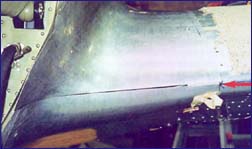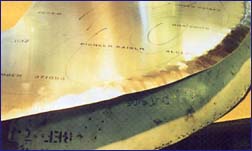Back to Part 1
|

This Provost wing root fairing is hand formed of 1100, and is now fit, trimmed and ready for gas welding
across the leading edge. Owner of the Provost is Mike Dale. |
|
Stearman gear-leg fairings are made of 1100, for instance, and the factory gas-welds have been planished to
such a high degree to make them nearly invisible, even under close scrutiny! Many parts made from this
alloy are in use away from abuse, so they may be left in a fairly soft condition. It is non-structural
material, and work hardens slowly. It anneals at 650
0
F with either water or air quench, and is O.K. for torch annealing. Being quite repairable, it also has high
corrosion resistance. Very thin laminates of this material are used for ALC LAD on the other alloys,
giving those alloys a corrosion resistant layer a few thousandths of an inch thick.
3003-(3S) consists of pure aluminum with 1.2% manganese added to increase strength (6K51-27K51 yield). This
alloy forms a little more slowly than 1100, work hardens faster, and welds just as easily. It is found as
fairings and fillets, tanks, tubing, wheel pants, nose bowls, and cowlings. Fairly deep shapes like wheel
pants may be formed without any annealing. It is a non-structural material and anneals at
775
0
F
with
|

This ``blanked" skin for a Kaman helicopter is plainly marked as a Kaiser product, .032" in thickness, 2024
alloy, 0 temper. Temper, alloy and thickness are the defining criteria for aluminums. Working a
deeply formed part like this, the craftsman asks himself the big question, ``Can I make it before
it gets too hard and either needs annealing or suddenly stress cracks?" |
|
either water or air quench Fine for torch annealing and quite repairable, 3003 is also very corrosion
resistant.
5052-(525) contains 2.5% magnesium and 0.25% chromium. It is a binary alloy and is well known as the highest
strength, non-heat treatable alloy (28K5I-3 7K51 yield) commonly available, as opposed to 5086, which is
the highest strength non-heat treatable alloy and not commonly available.
Widely used in industry for electronics chassis and kitchenware, 5052 is also regarded as a marine-grade
aluminum because of its high corrosion resistance. In aircraft it easily finds a home as wing ribs, wing
tips, tanks, pressure tubing, ducting, stiffeners and framework. While very weldable, it does work harden
rapidly and may therefore need frequent annealings. It has limited structural applications and anneals at
650 degrees F. The torch is just fine for annealing, and may be followed by quenching in either water or
air.
Continue





